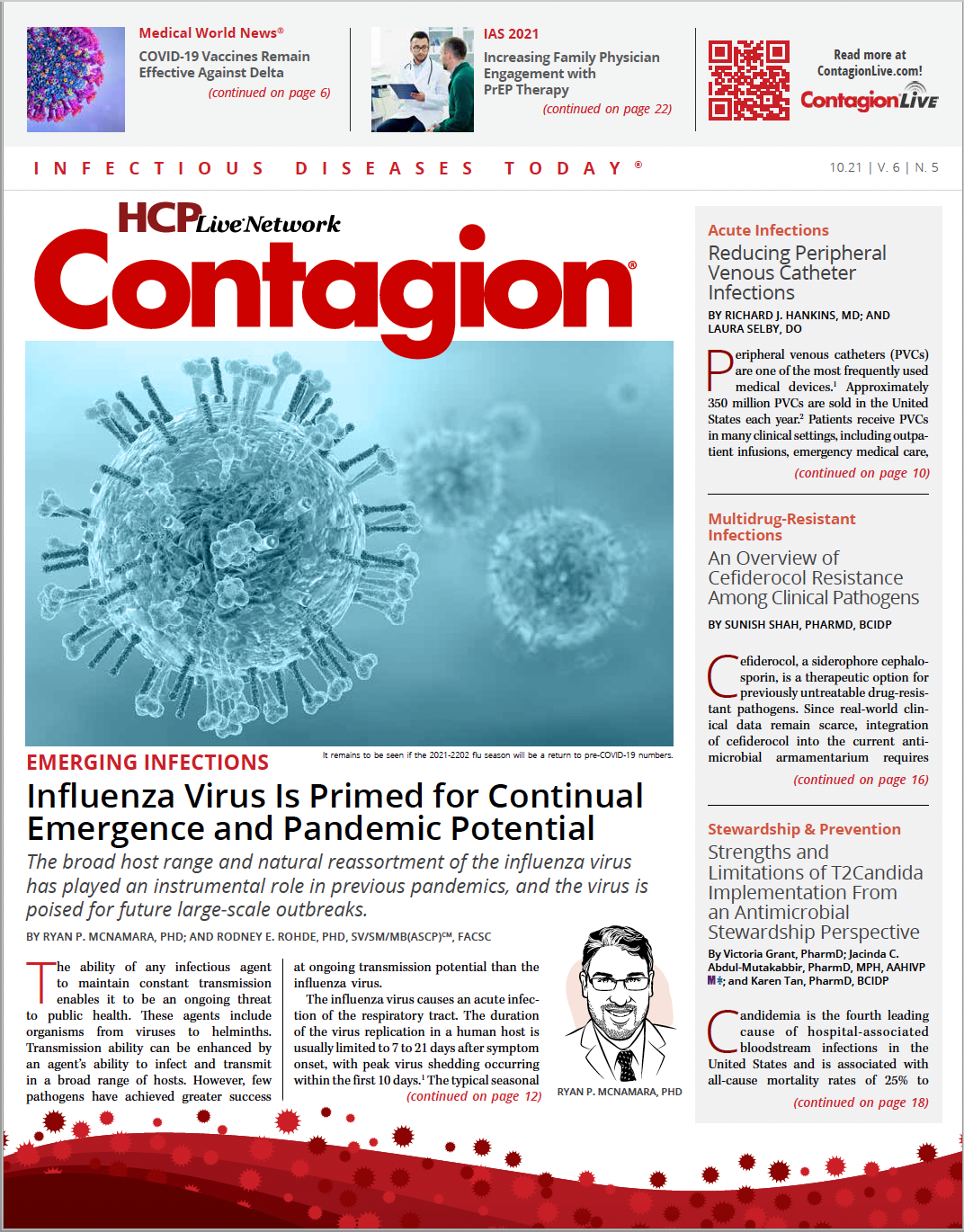Role of Immunosuppression on Community-Acquired Clostridioides difficile Risk
CDI remains an urgent public health threat and continues to be the most frequent cause of diarrhea among hospitalized patients and overall hospital-acquired infection in the United States.

Overall rates of Clostridioides difficile infection (CDI) have steadily declined over the past 10 years.1 This decline is thought to be primarily driven by a decreased rate of health care–associated CDI because of improved antimicrobial stewardship and infection control efforts in the inpatient setting. Rates of community-acquired CDI, however, remained unchanged over the past decade, with less robust antimicrobial stewardship initiatives found in the outpatient setting. Although this is a positive trend, CDI remains an urgent public health threat and continues to be the most frequent cause of diarrhea among hospitalized patients and overall hospital-acquired infection in the United States.2
Because of high CDI recurrence rates—estimated to be around 25% after an initial episode—and without widespread preventative strategies, identifying patients most at risk of CDI is of paramount importance.1,3 The most commonly identified risk factors for CDI include exposure to health care settings, advanced age, and comorbidities such as malignancy, solid organ transplant, chronic kidney disease, inflammatory bowel disease, and patients living with HIV.
Several drug-related risk factors have also been documented including antibiotics, acid-lowering medications, such as proton pump inhibitors (PPIs) and H2-receptor antagonists, and potentially nonsteroidal anti-inflammatory drugs.3,4 Although a link between the use of immunosuppressive medications and increased risk for CDI has been suggested, risk was historically associated with the frequent need for antimicrobial therapy and exposure to health care environments. Risk of CDI in immunosuppressed patients is also mediated by a blunted antibody response to C diff toxins, resulting in colonization and recurrent infections.5 In this trial, Varma and colleagues sought to further characterize the associated risk for CDI with various classes of immunosuppressant medications.6
Patients were included in this single-center retrospective cohort trial if they were tested for community-acquired CDI (CA-CDI) within 72 hours of hospital admission. The primary outcome in this study was incidence of CA-CDI. At this institution, the diagnostic testing algorithm for CDI included a single-step nucleic acid amplification test for toxin gene. Patients who received immunosuppression were determined through medication reconciliation upon inpatient admission. Patients were then stratified by immunosuppressant class: systemic corticosteroids, calcineurin inhibitors, antimetabolites, tumor necrosis factor α inhibitors, anti-CD20 monoclonal antibodies, and other classes.
Ultimately, 10,992 patients were enrolled in the study, with 1795 testing positive for CA-CDI. The infection was more common in patients who received immunosuppressants, were older than 75 years, had a Charlson Comorbidity Index of 4 or greater, experienced prior hospitalizations within 90 or 365 days prior to the index CDI episode, and used PPIs.
The most common immunosuppressant classes were systemic steroids and calcineurin inhibitors. Interestingly, CA-CDI was less frequent among patients who were exposed to antibiotics, relative to patients who tested negative.
In a multivariate analysis that adjusted for demographic and clinical considerations, calcineurin inhibitors were the only class of immunosuppressants found to independently increase risk of CA-CDI (OR, 1.19; 95% CI, 1.01-1.44). Further, in a sensitivity analysis intended to assess for additive or multiplicative effects of different classes of immunosuppressants, patients on 3 or more classes of immunosuppression had increased odds of CA-CDI (OR, 1.53; 95% CI, 1.25-1.87). When stratified by indication for immunosuppression and adjusted for baseline demographic and clinical variables, only solid organ transplantation (SOT) was associated with an increased risk of CA-CDI (OR, 1.25; 95% CI, 1.08-1.45).
Suggested explanations for immunosuppression-mediated CDI risk—such as a blunted antibody response to C diff toxin, intestinal dysbiosis leading to a loss of gut microbial resistance, or drug-induced damage to the gut epithelium through C diff–toxin mediated effects—would theoretically increase risk for CDI. However, this study suggested that this risk may not be shared across all classes of immunosuppressants. These data showed that among hospitalized patients, calcineurin inhibitors may increase the risk for CA-CDI compared with other classes of immunosuppression, and risk may also be increased among patients receiving multiple classes of immunosuppressants—especially patients on 3 or more classes. Unsurprisingly, when stratified by indication for immunosuppression, SOT was associated with increased risk for CA-CDI, which is among the most common indications for calcineurin inhibitors.
This study offers an interesting addition to our understanding of risk factors for CDI, although the findings were sometimes inconsistent with known risk factors for CDI, including administration of antibiotics. The retrospective nature of the study limited a full appreciation for true antibiotic exposure and immunosuppressant exposure prior to admission. Also, the CDI diagnostic testing algorithm included only a single-step polymerase chain reaction–based assay, which is unable to differentiate between active CDI and C diff colonization. Despite mentioning that the study center accepts only unformed stool samples, the authors did not elaborate on efforts either to distinguish symptomatic from asymptomatic patients, or procedures to rule out other etiologies for diarrhea on presentation. Lastly, the authors did not delineate the degree of CDI severity or incidence of fulminant CDI.
As noted in this study, patients receiving immunosuppressants are more likely to have more comorbidities and health care exposure relative to patients not on these medications, in addition to the potential additive risk of the medication itself, suggesting a multifactorial risk profile for patients receiving these medications. For clinicians with patients on calcineurin inhibitors, the key takeaway is that it would be prudent to be mindful of these patients’ increased risk profile for CDI. In the presence of clinical symptoms, it may be reasonable to have increased suspicion for CDI.
References
- Guh AY, Mu Y, Winston LG, et al. Trends in U.S. burden of Clostridioides difficile infection and outcomes. N Engl J Med. 2020;382(14):1320-1330. doi:10.1056/NEJMoa1910215
- Magill SS, O'Leary E, Janelle SJ, et al. Changes in prevalence of health care-associated infections in U.S. hospitals. N Engl J Med. 2018;379(18):1732-1744. doi:10.1056/NEJMoa1801550
- Eze P, Balsells E, Kyaw MH, Nair H. Risk factors for Clostridium difficile infections – an overview of the evidence base and challenges in data synthesis. J Glob Health. 2017;7(1):010417. doi:10.7189/jogh.07.010417
- McDonald LC, Gerding DN, Johnson S, et al. Clinical practice guidelines for Clostridium difficile infection in adults and children: 2017 update by the Infectious Diseases Society of America (IDSA) and Society for Healthcare Epidemiology of America (SHEA). Clin Infect Dis. 2018;66(7):e1-e48. doi:10.1093/cid/cix1085
- Kyne L, Warny M, Qamar A, Kelly CP. Association between antibody response to toxin A and protection against recurrent Clostridium difficile diarrhoea. Lancet. 2001;357(9251):189-193. doi:10.1016/S0140-6736(00)03592-3
- Varma S, Greendyke WG, Li J, Freedberg DE. Class-specific relationship between use of immunosuppressants and risk for community-acquired Clostridioides difficile infection. Clin Infect Dis. Published online June 22, 2021. doi:10.1093/cid/ciab567

